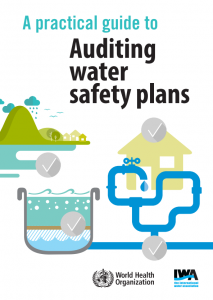This document aims to support the development and implementation of customized WSP auditing schemes by setting out the most important considerations and requirements, including:
• audit objectives
• audit methodology
• audit scope and depth of investigation
• audit timing and frequency
• auditor qualifcations
• auditor training and certifcation
• establishing audit criteria
• evaluating and reporting audit fndings.
Case studies, examples and tools from various WSP auditing schemes are included for illustrative purposes and are intended to provide helpful information to guide the development of tailored approaches.
This WSP auditing guidance document contributes to a growing body of practical WSP tools and resources developed by WHO and IWA, in collaboration with a number of other key partners. These include: the Water safety plan manual: Step-by-step risk management for drinking water suppliers (WHO/IWA, 2009); Think big, start small, scale up: A road map to support country-level implementation of WSPs (WHO/IWA, 2010); the WSP Quality Assurance Tool (WHO/IWA, 2013); the WSP training package (WHO/IWA, 2012) and the web-based Water Safety Portal (www.wsportal.org).


